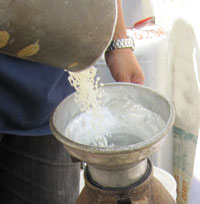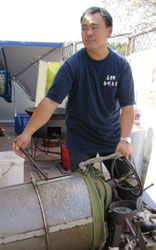Crispy Popped Rice Treats / 爆米香的好滋味
Crispy Popped Rice Treats
◎English text by Peng Hsin-yi
◎Photos by Yang Chan-hua, Tsai Yi-jen
 Mr. Wei He-li has over twenty years experience handling the pressure cooker responsible for the popped rice creations. As he spins the cylinder-shaped pod over a steady fire, his other hand stirs the malt sugar syrup that bubbles on top of the stove. There are a series of steps that go into the creation of popped rice treats and Mr. Wei has the process down to an art form. This precise timing is carried out at a steady and leisurely pace. The result, batch after batch of fragrant, gooey (but not overly sticky) popped rice treats.
Mr. Wei He-li has over twenty years experience handling the pressure cooker responsible for the popped rice creations. As he spins the cylinder-shaped pod over a steady fire, his other hand stirs the malt sugar syrup that bubbles on top of the stove. There are a series of steps that go into the creation of popped rice treats and Mr. Wei has the process down to an art form. This precise timing is carried out at a steady and leisurely pace. The result, batch after batch of fragrant, gooey (but not overly sticky) popped rice treats.
The treats began in the good old days with his grandfather and a childhood filled with the delicious fragrance of popped rice. The family business has been handed down three generations and is now carried out by Mr. Wei. Traditional rice popping pressure cookers are rarely seen these days. Mr. Wei makes sure he keeps the old tradition alive. He believes his trade should be cherished like any other traditional folk crafts. Sometimes Mr. Wei receives invitations from local primary schools to demonstrate the traditional rice popping process. It is his ambition to spread his passion for the traditional treats to a new generation of fans. He has even earned the nick name "Uncle Popped Rice". Some of the children actually seek him out after his presentation, to buy his popped rice treats.
 The basic ingredients include plain rice, glutinous rice or wheat. The grains are sealed in the pressure cooker and dry cooked over a slow fire for about 10 minutes, until it starts to pop. Mr. Wei always calls out "It's popping!", so people in the vicinity aren't startled by the noise. He then opens the pressure cooker, which lets out a loud bang! This is the sound that earned the treat the name "Popped Rice". He then transfers the popped rice into a mixture of raw sugar, malt sugar and vegetable oil that has been bubbling on the side. The rice and syrupy mixture are then carefully tossed so that every grain is evenly coated. Mr. Wei describes this as the most challenging step in the process and claims it takes years of experience to know when the syrup is the right consistency. The mixture is then poured into a wooden mold and spread evenly with a rolling pin. He simultaneously presses the syrup-coated grains into a firm block. Timing is of the essence as the huge block must be cut into serving pieces while it's still hot. They are then stacked into plastic bags and after10 minutes, when the blocks have cooled down, the excess moisture is let out. The bags are then sealed and the treats are ready to be sold.
The basic ingredients include plain rice, glutinous rice or wheat. The grains are sealed in the pressure cooker and dry cooked over a slow fire for about 10 minutes, until it starts to pop. Mr. Wei always calls out "It's popping!", so people in the vicinity aren't startled by the noise. He then opens the pressure cooker, which lets out a loud bang! This is the sound that earned the treat the name "Popped Rice". He then transfers the popped rice into a mixture of raw sugar, malt sugar and vegetable oil that has been bubbling on the side. The rice and syrupy mixture are then carefully tossed so that every grain is evenly coated. Mr. Wei describes this as the most challenging step in the process and claims it takes years of experience to know when the syrup is the right consistency. The mixture is then poured into a wooden mold and spread evenly with a rolling pin. He simultaneously presses the syrup-coated grains into a firm block. Timing is of the essence as the huge block must be cut into serving pieces while it's still hot. They are then stacked into plastic bags and after10 minutes, when the blocks have cooled down, the excess moisture is let out. The bags are then sealed and the treats are ready to be sold.
Mr. Wei's menu now features various rice treats, such as peanut, sesame, macron, etc. The best seller is the Double Peanut Popped Rice Treats. Mr. Wei told us his business fluctuates with the temperature. As sales drop in the hot summer months, his business is only in operation between Mid Autumn Festival (August 15th on the lunar calendar) to Tomb-sweeping Day (approximately mid March on the lunar calendar, or April 4th on the Gregorian calendar). However, Mr. Wei never sits idle during his months of hiatus. He is always thinking about how he can modernize his business, create a new presentation, design new packaging or develop new flavors. He hopes to attract more patrons and pass down the appreciation for this traditional snack.
爆米香的好滋味
◎文/侯雅婷
◎攝影/楊蟬華.蔡乙甄
老闆魏合利身手俐落地操作著傳統的爆米香壓力鍋,壓力鍋不停旋轉的同時,還一邊攪拌著麥芽糖。每個步驟,魏老闆做起來有條不紊,能夠這樣從容不迫製作「有點黏又不會太黏」的傳統點心-「爆米香」,是魏老闆累積20年經驗而成的。
魏老闆說家中從阿公時代開始就從事「爆米香」的工作,他是第三代,從小就是在熟悉的爆米香味道中成長,時至今日,很難找得到用傳統壓力鍋爆的爆米香了,這套爆米香工夫幾乎可說是一項民俗技藝。魏老闆現也受邀到國小的生活課展演「爆米香」完整的製作流程,讓小朋友認識傳統的美食文化,他也因此獲得「米香叔叔」的封號。米香叔叔說,上過課的小朋友,偶而想念那甜甜的古早味,還會專程跑來買他的爆米香。
爆米香使用白米、糯米或小麥作為原料,經壓力鍋加壓後約10分鐘即可開鍋。打開之前,魏老闆一定會大喊一聲「要碰了喔!」,讓一旁觀看的民眾做好心理準備,不要被巨大的「碰」聲給嚇壞了。之後,把爆好的米香倒入調著紅糖、麥芽和油的熱鍋中均勻攪拌,老闆說麥芽糖火候的掌握是最困難的步驟。接著,將米香放入平板模型中桿平、壓實顆粒,還得一股作氣,趁著米香熱熱的時候裁切、裝袋,大約10分鐘,米香就會冷卻下來,再將開口封起。
除了原味之外,魏老闆還研發花生、芝麻、通心粉等多種口味,其中以「加倍花生」最為暢銷,魏老闆還說爆米香的銷售量會隨著炙熱的天氣下滑,所以他每年製作、販賣爆米香的時間只有從中秋節到隔年的清明節。魏老闆針對這項傳統產業也有許多新想法,希望研發更多口味,並透過新包裝,滿足消費者的需求。